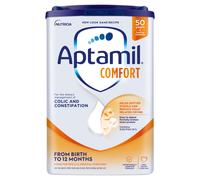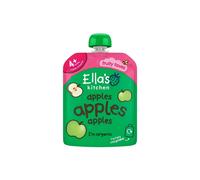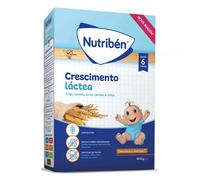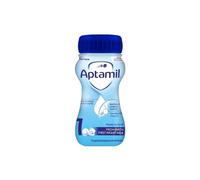Note: This text was created with the help of AI.








































- 1
- 2
- 3
- 4
- 5
- next page
Baby Food
The amount of food depends on your baby's age, weight and appetite. Your baby will let you know clearly if he or she is still hungry after a meal.
The following guideline values in millilitres apply as a rough guide for healthy and age-appropriate developing children:
- One month and older: between 80 and 120 ml of food per meal, about 400 to 800 ml per day.
- Two to six months: 120 to 180 ml per feeding, around 700 ml per day.
- From six months: 180 to 220 ml with each meal, around 900 ml a day.
Infant milk is a type of formula that is very similar to breast milk. Infant milk contains only lactose, no other carbohydrates and has a similar amount of protein to breast milk.
Infant milk can be given to your baby appropriately during the first few months. It is also suitable for your child during the first year of life, in addition to complementary food.
The start for complementary food is given by midwives and the experts between the fifth and seventh month of life. From this age, your child is ready for porridge, because then he needs more energy and nutrients.
In addition, the little ones in this age range are in a developmental stage in which they learn to use their own tongue no longer just for sucking, but to effectively push the porridge with it from the mouth into the throat.
If your infant is at increased risk of allergies due to a genetic predisposition, hypoallergenic food, or HA for short, can be a sensible supplement or alternative to breast milk. HA baby food varies from manufacturer to manufacturer, which is why you should always follow the instructions on the respective packaging.
However, the special food does not prevent all forms of allergy, but primarily you can reduce the risk of neurodermatitis. It is also important to seek advice from your paediatrician and midwife.
Basically, you should only change your baby's food if you have the impression that the current baby food is not good for your little treasure. If you do not notice any problems with your baby, there is generally no reason to feed a different brand. But even in this case, talk to your midwife or the paediatrician's practice you trust.
You will find information and instructions for preparing baby food on the packaging of the respective manufacturer. In general, you should always prepare the food fresh, i.e. shortly before feeding, as otherwise harmful germs can develop.
For the correct dosage of the powder, it is best to use the measuring spoon that is usually included. Then mix the baby food with boiled water. When shaking the bottle, make sure that no bubbles form. Otherwise your baby will swallow too much air, which can cause tummy aches. Before you give your baby the bottle, you should test for yourself whether the temperature of the food is comfortable.
At home, you can use boiled tap water. The lime and nitrate content of the water should be as low as possible. You can find out about these values from the water authority in your town or region. If you live in a house with old lead pipes, tap water is not an option.
In this case, or while on holiday abroad, still mineral water should be your water of choice. The label on the bottle will clearly state whether the water is suitable for preparing baby food.
The most suitable edible oils are cold-pressed and unrefined. Ideally, you should use oil from organic farming, because you don't have to worry about exposure to pesticides or pollutants. Whether you offer your baby commercial rapeseed oil, corn oil, olive oil, linseed oil or sunflower oil in organic quality is ultimately a question of taste.
Your youngest family member does not yet have an intact immune system in the first months of life. The immune system cannot yet reliably fight off possible bacteria and germs.
If you leave the prepared baby food for a few hours before reheating it and feeding it to your child, germs and bacteria from the air or from a spoon can attach themselves to the food and multiply.
Yes, prepared baby food can be kept in the freezer at minus 18 degrees for up to eight weeks. Under no circumstances should you let the food cool down first, otherwise germs and bacteria can develop. Therefore, we recommend that you put the freshly prepared and still warm portions directly into the freezer.
Baby Food
Food for very young children is an area which may sometimes seem utterly confusing for new parents. Of course, breastfeeding occupies a special place in their diet – but once the child grows up, it is important to introduce new flavours whilst looking after their health. From milk for newborns to flavoursome, fruity compotes, it’s important to choose well without breaking the bank.
Key nutritional needs
Food plays a major role in your child’s growth. It has an active impact on the child’s development, both physical and mental. It is therefore important to choose food carefully to avoid deficiencies or types of food which favour certain illnesses.
Newborn milk covers all the needs of your newborn baby aged from 0 to 6 months. With few proteins and fats, this milk offers small children a large number of vitamins and trace elements which are essential to their growth. This type of milk also comes in several versions depending on your child and their specific needs – prematurity, regurgitation, colic, allergies... This type of milk can replace breast milk completely.
Once your child is six months old – or is eating a real meal at least once a day – you can think about introducing stage 2 milk. This milk will help your newborn to grow and will supplement meals to make up for anything that is lacking. It is often considered to be a transitional product and is given alongside baby food for a balanced diet. Growing-up milk completes your child’s diet from 10 months onwards. This type of milk offers a dose of iron and essential fatty acids.
Dietary diversification is a vital step in teaching your little one to eat everything. But of course, this takes time. It’s best to progressively introduce new flavours to baby. We can start with vegetable-based baby food – green beans, spinach, broccoli or peas – then moving on to dishes made up of vegetables and meats from six months onwards. Then the time comes to offer fruit pots – apples, pears, apricots, mandarins – and all the sweet flavours, such as compote.
To allow your child to digest the new foods they are discovering, take your time. You will also discover that your little one prefers certain flavours. Your baby is developing his or her tastes, so take advantage of this to offer as wide a range of different flavours as possible.
The texture of baby food is more or less semi-liquid to allow your child to eat without any difficulty. From the age of nine months, your child will be able to learn to chew. You will be able to add to your child’s meals at this stage with finger biscuits or pieces of bread.
Buy nutritious products which are perfect for your child...
Whether your little one is on baby milk or solid food, feeding them can be very expensive. It’s therefore better to choose high-quality food at low prices. You should therefore check the ingredients in every recipe to offer your child the best. Forget baby food that contains too much salt, which is damaging to the kidneys. Go for baby food that is made from natural food and flavourings – and not just aromas. Also keep an eye on the sugar content. If you give your child very sugary baby food, then your child will become accustomed to this flavour and will seek it out when they grow older.
If you want to get your child into good habits, you can give them organic food. More and more brands are offering organic baby food at reasonable prices.
To ensure that your toddler has a varied diet, you will need to vary the menus as much as possible. But be careful. As we have already said, introduce each new food progressively. It’s also a very useful way of knowing whether your child has an allergy to a certain type of food.
Your child will be able to start with specific dairy products such as yoghurts for young children. You can then introduce vegetables and then fruit. Start with simple flavours and then progressively add more complex flavour combinations. If you are worried about making mistakes, you can go for full dishes created by manufacturers specialising in food for young children.
To make a success of starting solids, watch your child and how they react to different foods. Between six and nine months, you can introduce white meat and fish. From nine months onwards, your child’s plate can include red meat and starchy foods.
... without spending too much
You will see, feeding your child is quite a job. This is particularly true as the financial aspect can also be restrictive. When trying to find the best product which suits both your little one and your purse, you can spend many hours comparing different offers or running from one shop to the next.
But this can quickly become very time-consuming. This is why finding some help with this can rapidly become essential if you are to avoid getting tired of it unnecessarily.
At pricehunter.co.uk, we have searched through all the offers available on the Internet and we have compared them for you. You will be able to quickly find the best prices on the products you are looking for.
You’ll be able to find the best offers on the newborn milk you need, without wasting any time. You’ll also find growing-up biscuits, indulgent purées and fruit in squeezy pouches... We have also listed certain more specific items such as vegan cooking oils or alternative milks, as well as vegetable drinks which are becoming more and more popular for children older than 24 months.
There’s no sense in spending time in front of your computer screen – we’ve done it for you! All you have to do is let us know what you’re looking for and we will suggest the best prices. It’s simple and easy. And if you are trying to choose between several yummy things for your toddler, the low prices will allow you to make good choices without worrying about your budget, as a young mother. This is the best way to get good deals online and to make your child happy. It’s also a good solution to feed your child as well as possible and preserve their health. Our pages are updated regularly. That lets you check the offers in real time. You can find out immediately which retailer is offering the product you are looking for at the lowest price.
Note: This text was created with the help of AI.